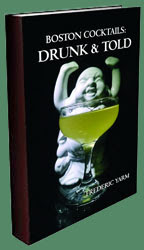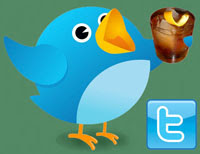 1 oz Rittenhouse 100 Rye
1 oz Rittenhouse 100 Rye1 oz Calvados
1 oz Lillet Blanc
3/4 oz Lemon Juice
3 dash Peychaud's Bitters
Shake with ice and strain into a cocktail glass. Garnish with a Luxardo Maraschino cherry.
At "The Bad, Bad Boys of Saloons" talk, authors Christine Sismondo and James Waller (*) explored the seamier side of the bar trade. Despite all of the talk about craft bartenders who have raised bar standards through the last century and a half, plenty of saloon owners were filling the opposite end of the spectrum and this talk was to honor them -- about drinking wrong. The Anti-Saloon League that gained force leading up to Prohibition summed up these saloons as:
The saloon is the storm center of crime; the devil's headquarters on earth; the schoolmaster of a broken decalogue; the defiler of youth; the enemy of the home; the foe of peace; the deceiver of nations; the beast of sensuality; the past master of intrigue; the vagabond of poverty; the social vulture; the rendezvous of demagogues; the enlisting office of sin; the serpent of Eden; a ponderous second edition of hell, revised, enlarged and illuminated.However, as our talk's hosts point out, bad bars are homes to people, too. Immigrants often received charity at these establishments, and they, gay men, politicians, and frontiersmen made these places a part of their life. Often, these places were written about in a pathological way; meanwhile, the rich at the Waldorf-Astoria were deemed to be drinking right even when they started in the morning.
The immigrant section of the talk discussed the rise of the German beer gardens. While these establishments were often villainized, they were generally family friendly places that served lower proof drinks than most other bars. With World War I looming, the Anti-Saloon Leage targeted them as aiding and abetting the German Reich. Both the beer gardens' and the saloons' prices were often controlled by the brewers which caused some financial difficulties. While the beer gardens kept a more respectable air, many saloons needed to supplement their income to survive, and thus, they were sometimes forced to add amenities such as gambling and prostitution to make up for the price control. This gave the Anti-Saloon League even more ammunition. For more on the beer halls, Maureen Ogle's Ambitious Brew: The Story of American Beer was suggested reading.
Besides a sense of community, these saloons offered a safe drinking source. Even though the tenement housing's water was not as polluted as the Europe they had just fled, safety was still on their mind. Furthermore, the saloons offered an escape from their tiny, cramped living quarters. The speakers cited Upton Sinclair's The Jungle as a good literary reference to this time period.
Moving on to politics, the concept of buying votes through booze, such as in Tammany Hall, was discussed. While the article in the The Balance and Columbian Repository gained fame for where the cocktail was mentioned and later defined in 1806, the point of the article was the vast tally sheet of drinks that were purchased in trade for votes. All that booze was for naught, save for giving cocktail historians an artifact to study, since that candidate in the end lost the election. The outrage against the buying of votes supported the idea that Prohibition was not about drinking per se but about controlling its distribution and sale. Sismondo and Waller offered up Jack London's John Barleycorn as a love letter to a bar that included a glimmer of how a bar worked in election time; there local politicians made the rounds, the booze flowed like water, and in one parade London joined in on, he did not even know or care who he was campaigning for. While some politicians were drinkers, others had to pretend to drink if they wanted to get elected; many were spotted and slammed in the press for leaving bars walking perfectly straight.
The final section of the talk dealt with gay and leather bars and the political unrest leading up to the gay rights movement. One of the most famous ones they discussed was the Stonewall Inn. The Stonewall, like the Sewer and the Snakepit, offered up protection for gay men and women to live their lifestyle. With that came a price which included an expensive cover charge, exorbitant drink prices, watered down drinks, backed up toilets, and the like. Between the mafia who ran the establishment and the police who continually raided it, there was eventually a major uprising that led to four nights of rioting in Greenwich Village in June of 1969.
Somewhere in the middle of the talk, after a PBR had been proffered and a Muleskinner mixed up, a Corpse Reviver was served (recipe above). It was provided as an example of a breakfast drink, and by today's standards, drinking first thing in the morning is a bad idea; such bad ideas are often linked to bad bars. This drink had a fruity lemon and apple sip, and the swallow brought out the lemon's crispness and the rye's barrel-aged notes.
During the question and answer session, they were asked about the difference between a bad bar and a dive bar, the answer was, "A bad bar is one a hipster won't go into, but a dive bar they will."
(*) Christine's latest book, America Walks into a Bar: A Spirited History of Taverns and Saloons, Speakeasies and Grog Shops and James' latest volume of his series, Drinkology: The Art and Science of the Cocktail are both available on Amazon.
 The 2017 collection of 855 drink recipes, bartender tributes, and essays on hospitality from CocktailVirgin's Frederic Yarm. Available at
The 2017 collection of 855 drink recipes, bartender tributes, and essays on hospitality from CocktailVirgin's Frederic Yarm. Available at  The 2012 collection of 505 drink recipes, techniques, and Boston bar recommendations from Frederic Yarm. Available at
The 2012 collection of 505 drink recipes, techniques, and Boston bar recommendations from Frederic Yarm. Available at 




No comments:
Post a Comment